Business Impact

say coaching and mentoring contribute to their business success to a very high degree

Leadership is among the hottest HR issues of 2025, according to new research from the HR Research Institute. We believe that this partially explains why two-thirds of today’s organizations view coaching and mentoring as strategic priorities this year.
How hot is the topic of leadership development? As of December 2024, we asked 505 HR professionals to identify the most important HR issues headed in 2025, we found that leadership development was the second most widely selected answer, behind performance management. As of May 2025, we are asking the same question again and, so far, leadership development has ascended to the top-ranked issue!
Meanwhile, we have also found that “preparing employees for new roles and assignments” is among the top reasons for harnessing coaching and mentoring, mentioned by 56% of participants.
Of course, our research is not alone in indicating a relationship between leadership and coaching. For example, a survey by Harvard Business Review Analytic Services reports that 86% of organizations consider personalized approaches like coaching and mentoring as essential for leadership development.
Further, companies with structured coaching programs have seen a 60% boost in leadership effectiveness and a 95% increase in skill development interest, according to the International Coach Federation.
Although we found that two-thirds of HR professionals surveyed identify coaching and mentoring as strategic priorities, only 45% report that these initiatives have meaningfully contributed to business success to a very high degree (at least 8 on a 10-point scale).
The shortfalls are linked to execution. Turning coaching and mentoring into a real lever for leadership development requires more than good intentions. High-performing coaching and mentoring programs are more than three times as likely to reward internal coaches, track program impact through retention and engagement data, and support supervisors in developing coaching skills.
The future belongs to companies that treat coaching not only as a checkbox but as a core leadership competency woven into the fabric of their culture. This study aims to help HR professionals close this divide by providing a comprehensive roadmap for building coaching and mentoring programs that are strategic, measurable, and deeply embedded in leadership development practices.
We begin with a quick summary of many of the key findings of the report.
1. Coaching and mentoring are priorities for most organizations. However, there are mixed reviews when it comes to business success.
2. Several factors are driving the usage of coaching and mentoring programs today and in the future.
3. While coaching and mentoring are highly valued, they are often overlooked when it comes to formal recognition, rewards, or sufficient training support.
4. There are significant barriers to improving coaching/mentoring and measuring its effectiveness.
5. Most organizations use video technologies for coaching and mentoring, but under half adopt other digital tools at scale.
6. Compared to organizations with less successful coaching/mentoring programs (C&M laggards), those with highly successful coaching/mentoring programs (C&M leaders) are:
For purposes of this report, and within the context of the survey itself, we have defined coaching and mentoring as follows:
Do coaching and mentoring contribute to organizational success? A substantial portion (45%) of HR professionals indicate that coaching and mentoring contribute to their organization’s business success - that is, an 8 or above on a 10-point scale. The same is true when it comes to mentoring’s impact on business success. However, a similar proportion of organizations (44%) still feel their coaching and mentoring programs are underwhelming.
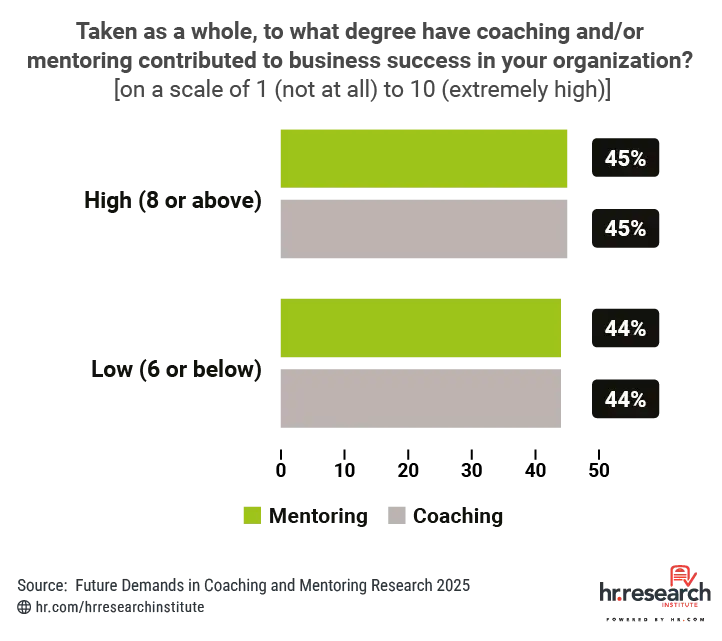 Editor’s Note: Those who answered “don’t know” (15% for coaching and 16% for mentoring) and “not applicable” (9% for coaching and 8% for mentoring) were removed, and the data were recalculated. We have also removed the responses from those who selected 7 since we consider this rating to be neither high nor low in this context.
Editor’s Note: Those who answered “don’t know” (15% for coaching and 16% for mentoring) and “not applicable” (9% for coaching and 8% for mentoring) were removed, and the data were recalculated. We have also removed the responses from those who selected 7 since we consider this rating to be neither high nor low in this context.
We wanted to analyze the differences between those organizations with highly effective coaching and mentoring initiatives and those with less effective ones. We started by dividing our sample into two cohorts:
We took a closer look at key differences across multiple coaching and mentoring practices between these two cohorts. Of course, correlation is not the same as causation. While we cannot state that any practice will lead to success, we do see intriguing relationships that may result in greater success.
Most organizations utilize coaching and mentoring programs, showing varied maturity. A quarter started coaching programs in the last 1-4 years; similarly, 24% initiated mentoring programs in the same time frame. Others have more established coaching and mentoring programs (22%), which have existed for over 10 years.
However, a considerable share of organizations lack coaching (26%) and mentoring initiatives (29%) altogether. This signals different implementation paths and potential barriers, requiring HR strategies for both launching new initiatives and updating mature ones to keep current.
Large organizations are much more likely to have coaching (62%) programs going for five years or more compared to only a quarter of small (27%) and midsize organizations (24%). Over forty percent of small and midsize companies do not have or use coaching programs, compared to only 9% of large organizations. Of course, larger organizations are simply more likely to have existed longer, so we’d be surprised if we didn’t see these correlations. On the other hand, we might also infer that these programs can enable organizations to grow and prosper long enough to become large organizations.
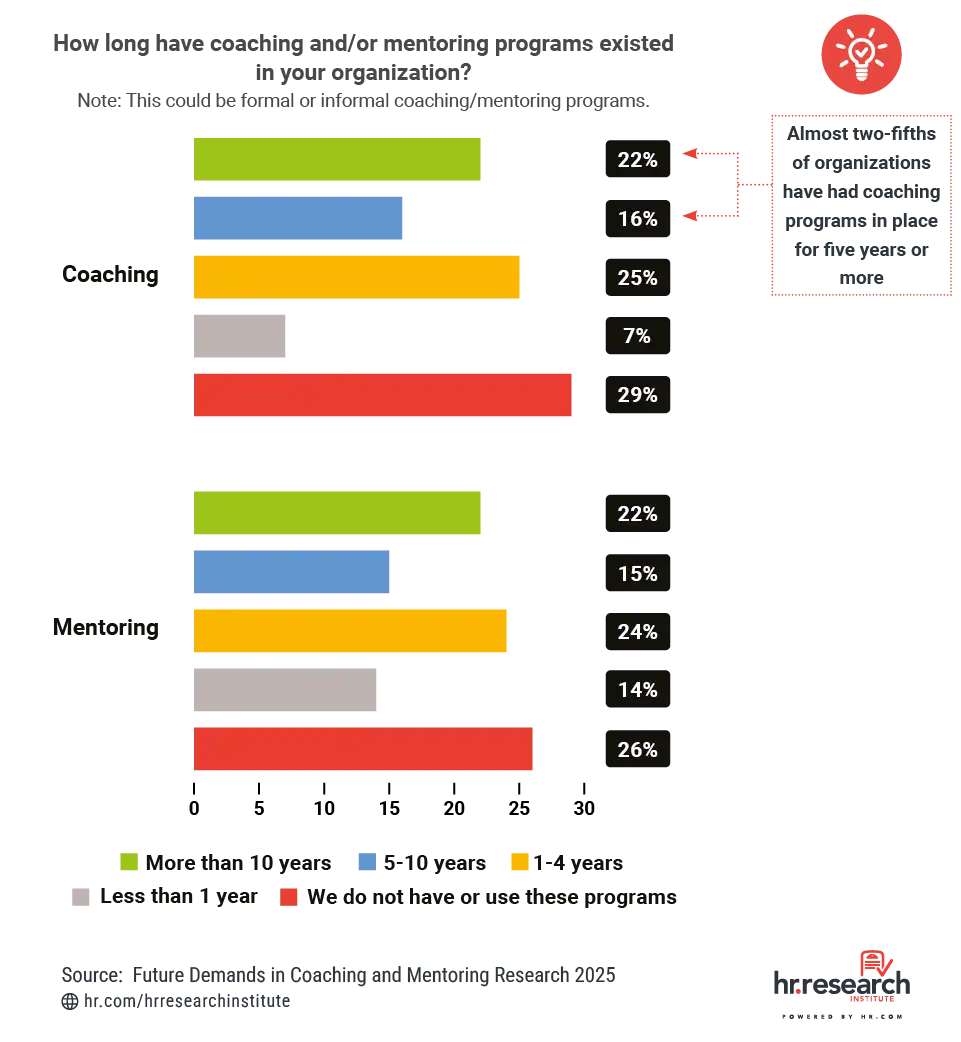 Editor’s Note: Those who responded “don’t know” were removed from the data and the numbers were recalculated accordingly. Note that those who stated they do not have either coaching or mentoring programs were not asked to answer many of the other questions in the survey.
Editor’s Note: Those who responded “don’t know” were removed from the data and the numbers were recalculated accordingly. Note that those who stated they do not have either coaching or mentoring programs were not asked to answer many of the other questions in the survey.
Coaching and mentoring (C&M) leader organizations are two times more likely than C&M laggard organizations to say their coaching programs have existed for five years or more. They are also significantly more likely than laggards to have a mentoring program that has existed for at least five years, at 45% and 27% respectively. This suggests that C&M laggards are in the early stages of building structured support and may still be experimenting with implementation.
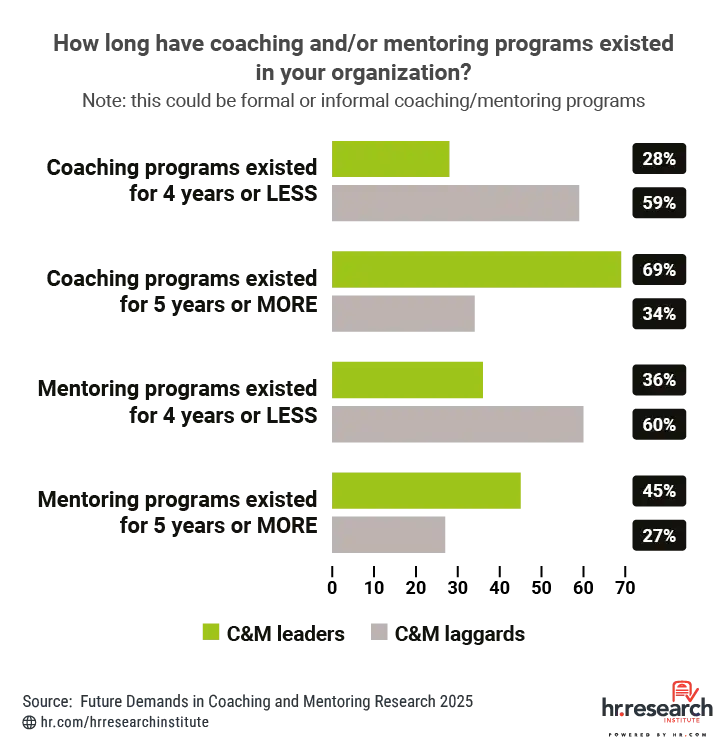
Most organizations acknowledge the strategic importance of coaching and mentoring. Over two-thirds of organizations agree or strongly agree that coaching and mentoring are strategic priorities. However, this leaves quite a few organizations that don’t consider coaching or mentoring a priority.
This data reveals an opportunity for organizations to further emphasize coaching and mentoring. Organizations that already view these as strategic priorities can deepen their commitment. Organizations that do not yet see them as strategic priorities can consider the potential advantages of implementing or enhancing these programs.

The vast majority of C&M leader organizations agree or strongly agree that coaching (85%) and mentoring (92%) are strategic priorities. In contrast, considerably fewer laggards say coaching (53%) and mentoring (54%) are strategic priorities.
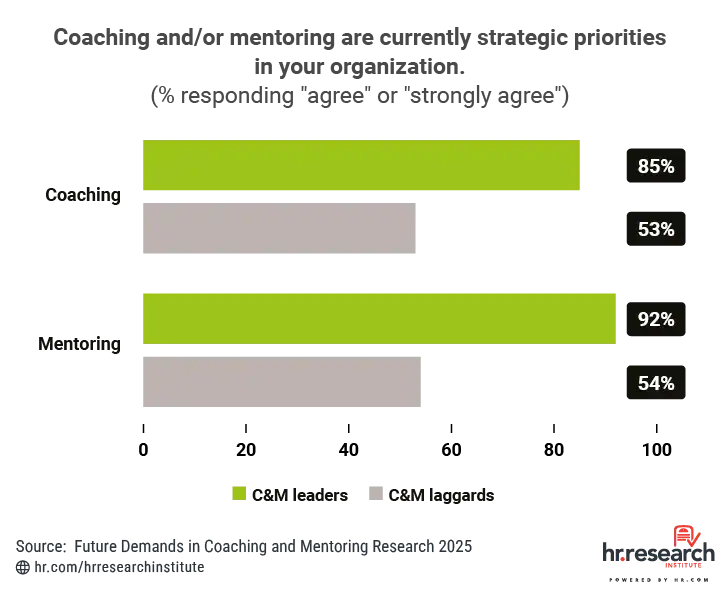
A clear majority of respondents believe that coaching and mentoring will gain importance in the next two years. For coaching, 61% of respondents either agree or strongly agree that their organizations plan to place greater emphasis on it. Mentoring fared similarly, with 63% indicating growing importance. These responses suggest a broad organizational intent to invest more heavily in development-related efforts.
In contrast, only 27% said the same for sponsorship programs, with “Don’t know” being the most common response. This points to a lack of clarity, structure, or prioritization around sponsorship as a formal talent development tool.
The disparity between coaching/mentoring and sponsorship highlights a missed opportunity. While the former are often tied to personal growth and performance, sponsorship plays a critical role in career advancement, particularly for underrepresented talent. Organizations aiming to close equity gaps and strengthen leadership pipelines should consider giving sponsorship more strategic attention.
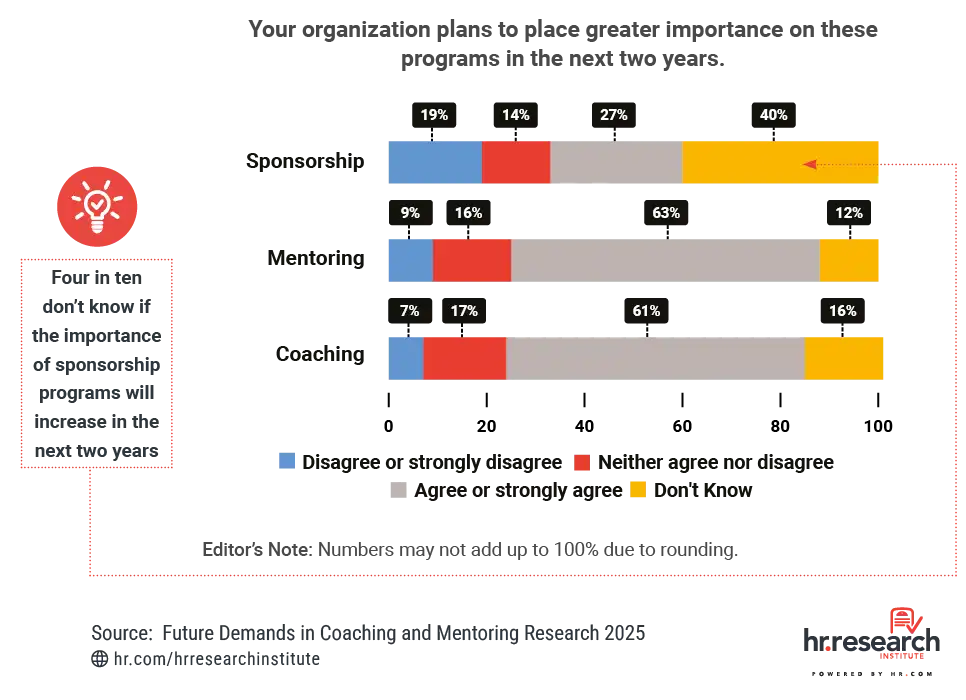
Sponsorship programs connect leaders with high potential individuals, or sponsees. Sponsors advocate for the individual and their work, provide guidance and support, create opportunities and leverage their position to give higher visibility to the sponsees.
Both C&M leader and laggard organizations anticipate placing greater emphasis on coaching and mentoring. But high-performing organizations express more confidence across all three areas.
While 91% of the leader organizations strongly agree that coaching will receive greater emphasis in the next two years, only 55% of low performers say the same. A similar gap exists for mentorship; 89% of leaders saying they will place greater importance on these programs compared to just 54% of laggards.
The most significant gap, however, pertains to the importance placed on sponsorship, with a whopping 60 percentage point gap. Based on this data, we can infer that C&M leaders are much more likely to have clarity around sponsorship as a development tool.

Based on our research, please consider the following suggestions:
Organizations primarily use coaching and mentoring to enhance employee performance and development. Sixty-four percent of organizations use coaching and mentoring to help employees improve job performance and face specific challenges. Sixty-one percent provide guidance to help employees realize their potential.
Other key reasons organizations utilize coaching and mentoring include improving employee engagement/retention (52%), creating a positive organizational culture (51%), and reinforcing employee upskilling (50%). Overall, organizations leverage coaching and mentoring for a variety of purposes, all centered around improving their employees and organizational culture.
Looking at the reasons that organizations have engaged in coaching and mentoring over the past three years, we find that the ranking of reasons remains similar. However, a considerably greater proportion of respondents have chosen the four reasons cited in the chart below, this year, suggesting these are rising as priorities among many coaching and mentoring programs.

Looking ahead, organizations see coaching and mentoring as tools for improving both individual and organizational performance. The top reasons cited for using these programs over the next two years include improving employee engagement and retention (59%), preparing employees for new roles or assignments (56%), and creating a positive organizational culture (55%).
Half of the respondents also expect these programs to be used to boost employee confidence and morale, while 42% plan to use them to support career guidance.
As organizations increasingly aim to strengthen culture and prepare talent for emerging needs, these programs are poised to evolve into strategic enablers of growth, resilience, and workforce agility.
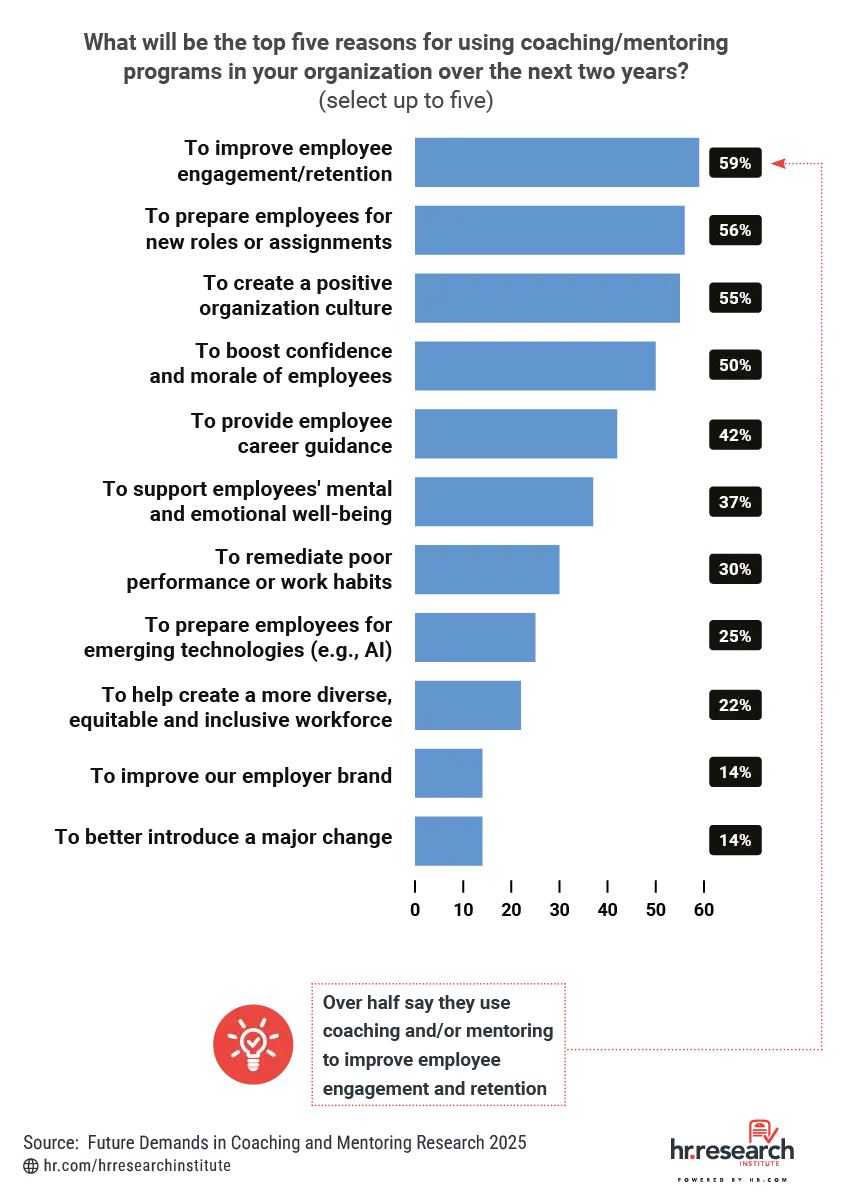
Looking back over the past four years, we see that respondents are placing a higher value on almost all of the reasons for using coaching/mentoring with one exception. In our current report, only 22% say they plan to use coaching/mentoring to help bolster diversity, equity, and inclusion in the workplace, a slight increase from 2023 but lower compared to 2021 (38%), and 2022 (44%).
Organizational culture plays a key role in the success of coaching and mentoring programs. Two-thirds of organizations agree that supervisors are strongly encouraged to develop their skills. However, only 51% say that internal coaches are well-trained, and 45% say the same about internal mentors.
Furthermore, while 36% agree that all employees are well supported in reaching their full potential, a substantial percentage of organizations neither agree nor disagree with this statement.
These findings indicate that while many organizations have the tools and support systems for great coaching and mentoring programs, they could be doing more to reach their full potential. Strengthening the training of internal coaches and mentors, fostering a culture that prioritizes employee development, and ensuring consistent support for all employees can help organizations bridge the gap between intention and impact.
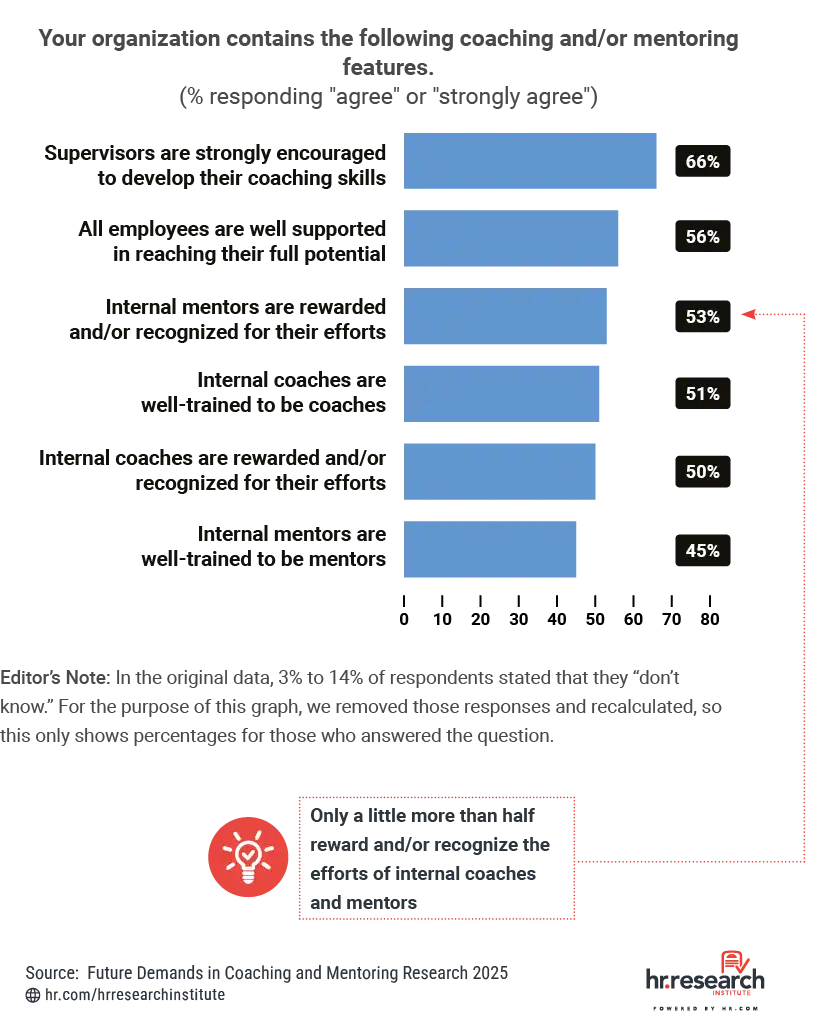
In C&M leader organizations, internal coaches and mentors are more often recognized, rewarded, and trained for their roles. At least three-quarters strongly agree that these individuals are well-trained. By contrast, laggard organizations report far less consistency. Only 38% say internal coaches are well-trained, and even fewer say mentors are well-trained (24%).
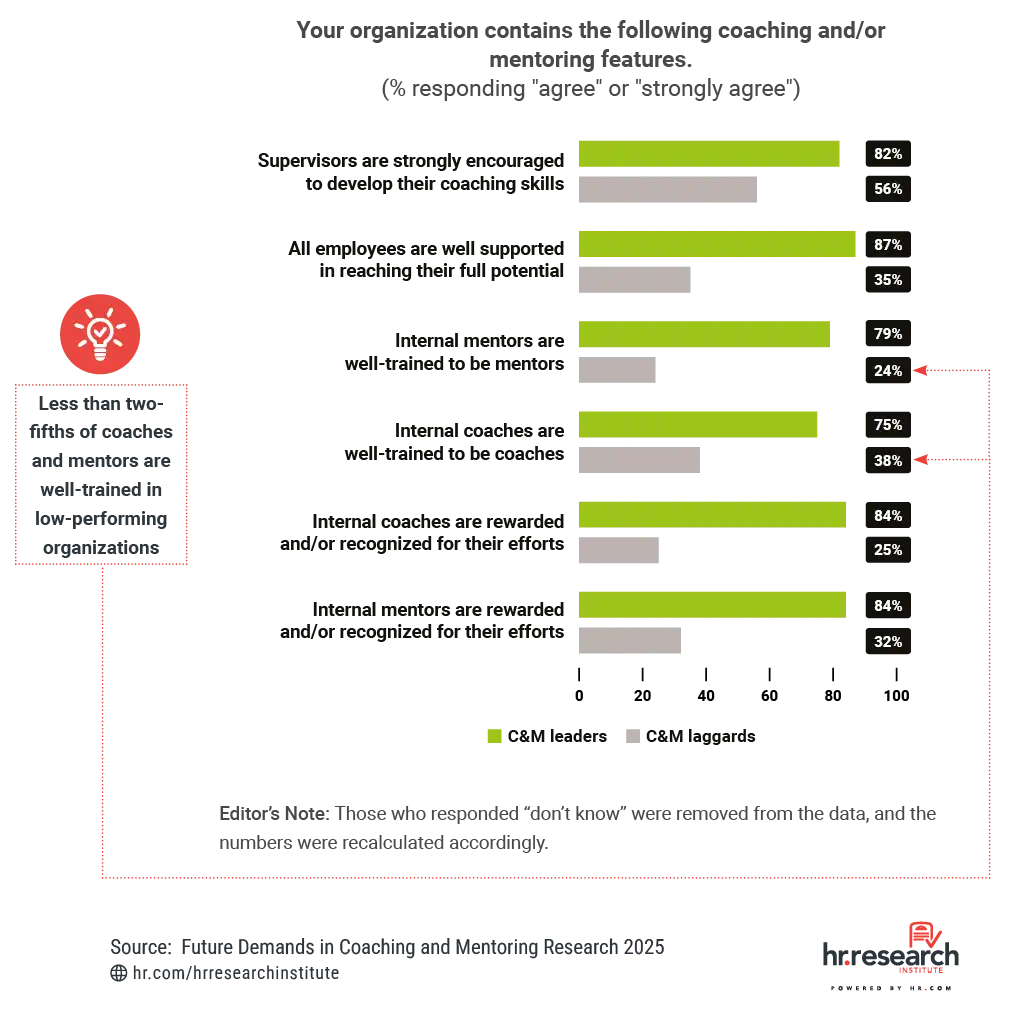
Based on our research, please consider the following suggestions:
Six in 10 organizations do not have sponsorship programs. For organizations that do have sponsorship programs, 24% say sponsors are typically senior-level managers, sponsor-sponsee relationships are often goal-oriented (21%), and sponsees are often chosen based on their potential to succeed (17%).
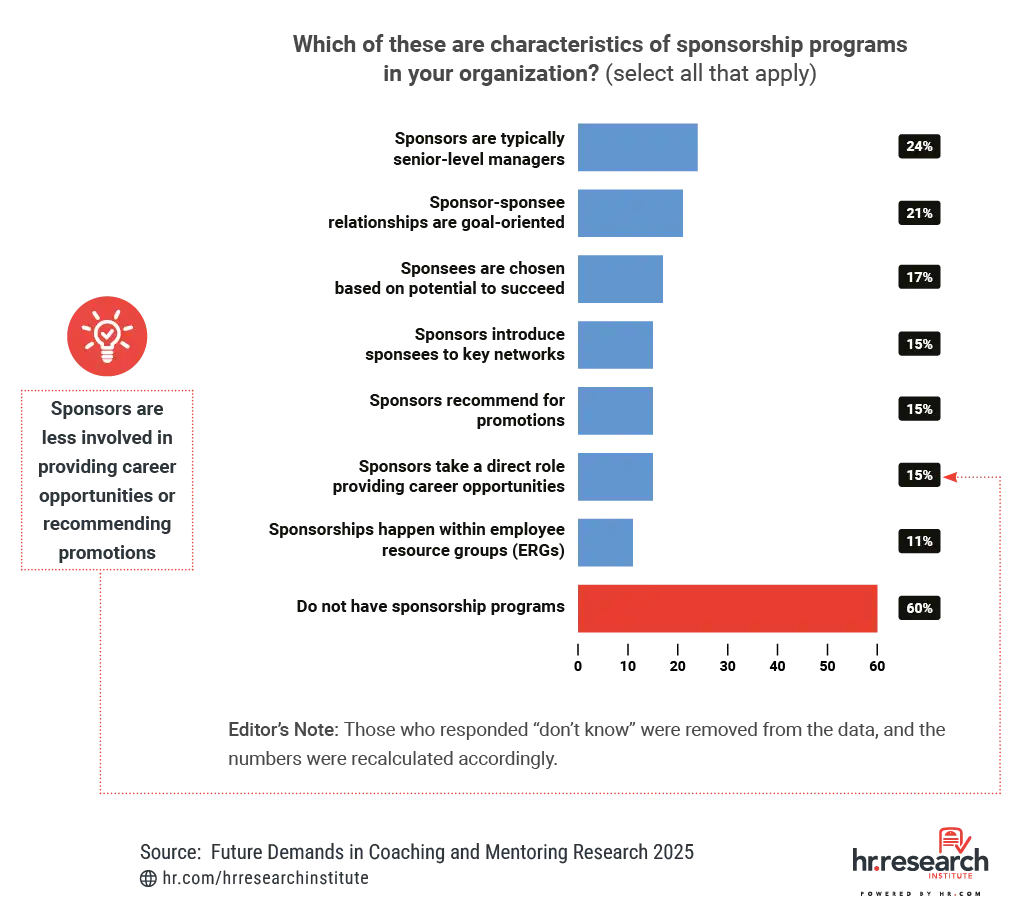
The top challenges hindering coaching and mentoring programs are largely structural and behavioral. Most (55%) respondents said their organizations do not devote enough time to these activities. The second biggest challenge (43%) is that managers avoid difficult conversations, suggesting discomfort or lack of confidence in handling sensitive topics.
Other barriers cited include a lack of concrete options for training, development, and career pathing (38%) and an absence of clearly defined, measurable outcomes (33%). Budget constraints were also a concern for 30% of respondents.
These findings reflect a broader organizational hesitation to fully commit to coaching and mentoring as strategic practices. Without sufficient time, structure, and resources, even well-intentioned programs can falter. To address these gaps, employers may need to equip managers with stronger conversational tools, define success metrics, and ensure that development efforts are integrated into broader talent strategies.
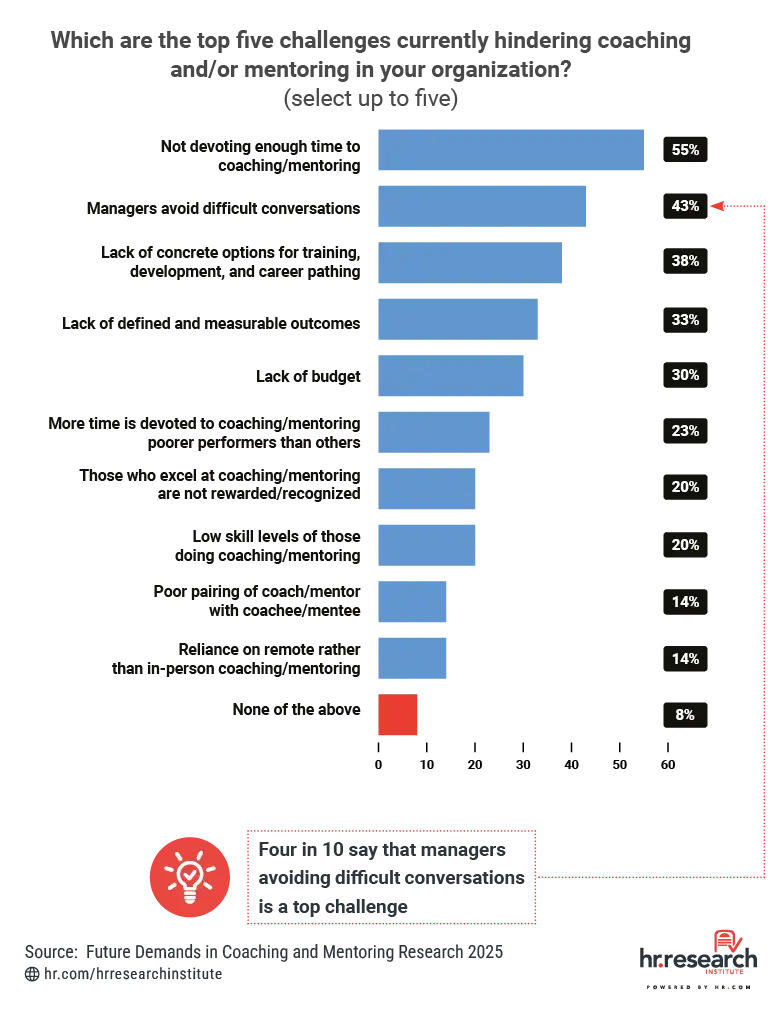
Two challenges are cited more by the laggard organizations. Lacking concrete options for training, development and career pathing is a challenge for 46% of C&M laggards but only for 23% of the leaders. Also, laggards (29%) are three times as likely than leaders to say inadequate skills are obstacles (10%).
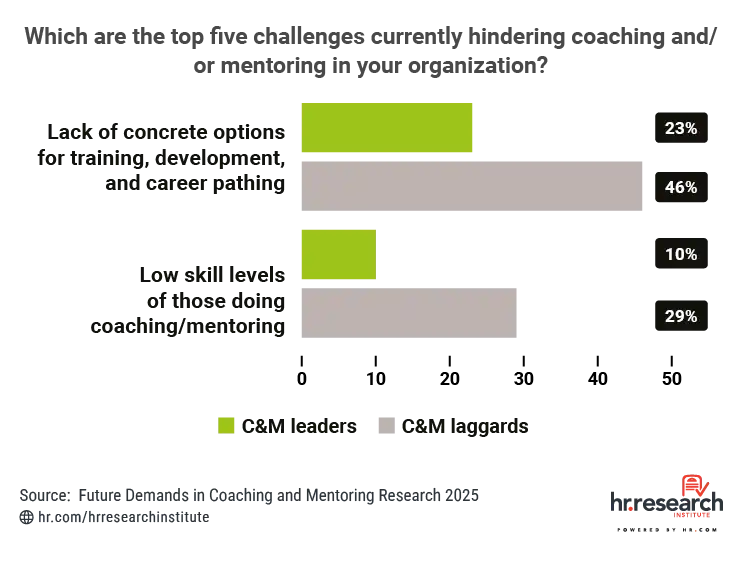
Based on our research, please consider the following suggestions:
Perhaps one of the reasons that coaching and/or mentoring are not more widely used is that organizations are not adequately measuring their effectiveness. Nearly half (47%) of respondents use participant feedback to measure the effectiveness of their coaching programs. While this is an important data point, it is very subjective. Fewer respondents are using more objective measures, such as performance metrics (37%), retention rates (37%), or career advancement (29%).
These metrics indicate interest in the broader impact of coaching and mentoring. However, 23% of organizations do not measure effectiveness at all. This lack of measurement hinders ROI assessment and improvement efforts. It also raises questions about organizational commitment to these programs.
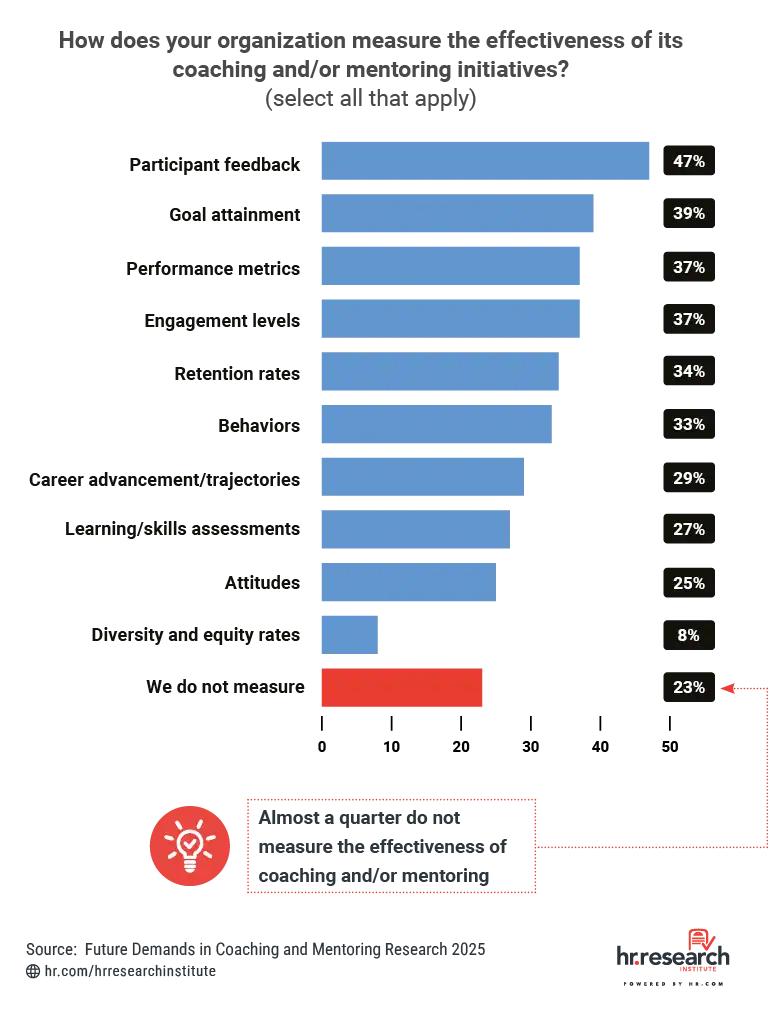
While 63% of the leader organizations use participant feedback to measure coaching and mentoring impact, they also track career advancement (58%), engagement (53%), and retention rates (53%).
In contrast, the laggard organizations rely more heavily on participant feedback (39%) and less than a quarter use additional measures. Notably, nearly one-third (32%) of laggards do not measure impact at all.
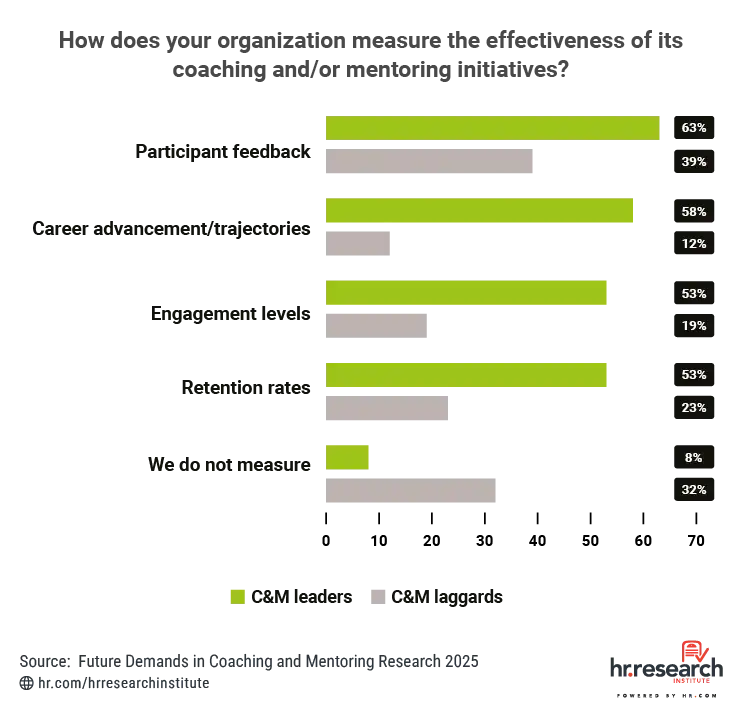
Respondents identified several coaching strengths, with the most commonly selected being the ability to build rapport and trust (65%), followed by listening to gain a better understanding (55%) and giving useful feedback (54%). Nearly as many noted coaches are good at helping others develop strategies for achieving goals (54%).
When asked about mentor strengths, HR professionals most often selected building rapport and trust (59%), giving useful feedback (59%), and having relevant experience (58%). This suggests that mentors are valued for their wisdom and guidance.
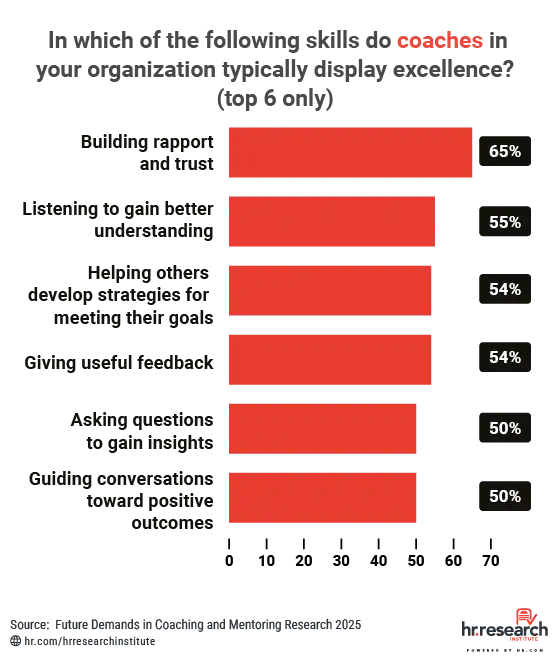
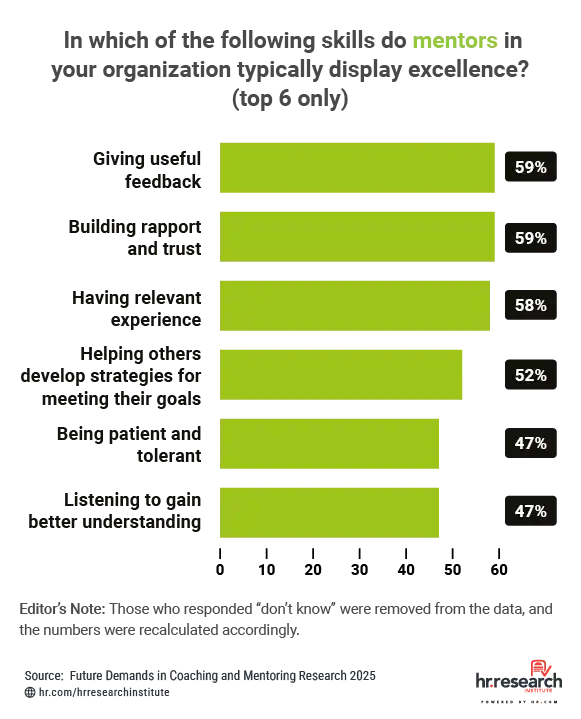
C&M leaders are significantly more likely to say their coaches demonstrate key skills effectively. These include building rapport (78%), helping others to develop strategies to meet their goals (68%), guiding conversations to successful outcomes (62%), and holding difficult conversations successfully (57%).
Conversely, the majority of coaches in C&M laggard organizations only displayed excellence in the build rapport category. While it’s important to build rapport and trust, organizations need to take a holistic approach to coaching to ensure success.

Based on our research, please consider the following suggestions:
Coaching and mentoring responsibilities are distributed across various roles within and outside organizations. Direct supervisors are a primary source of coaching. Twenty-one percent of organizations say direct supervisors do the most coaching. HR (17%) and external experts (15%) also play significant roles.
Mentoring is primarily an internal activity. Executives and senior managers are the most common source of mentoring (20%), followed by colleagues and peers (19%). Executives and senior managers often have the most knowledge of the organization’s mission, vision and values making them prime candidates for mentoring. Peers are also great sources of learning as they have different skills and come from a variety of backgrounds allowing them to knowledge share for a more well-rounded workforce.
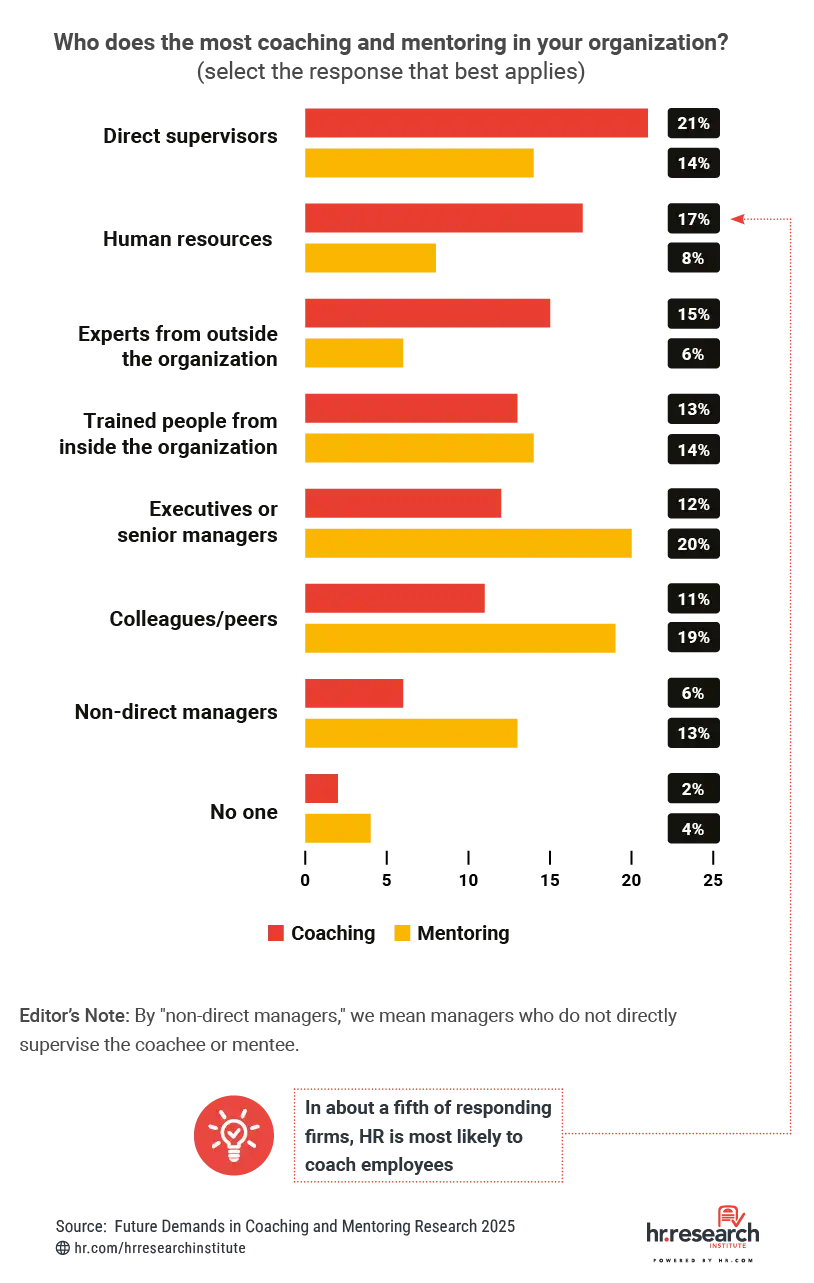
Only 35% of HR professionals see managers as actual coaches. The rest say managers either coach informally (28%) or just give performance feedback (26%). Another 7% aren’t even sure how to define coaching.
This points to a lack of clarity and structure in the areas of coaches and coaching. We believe that the more organizations can train managers in coaching skills, the more likely these efforts will benefit employee engagement, retention, and the business.
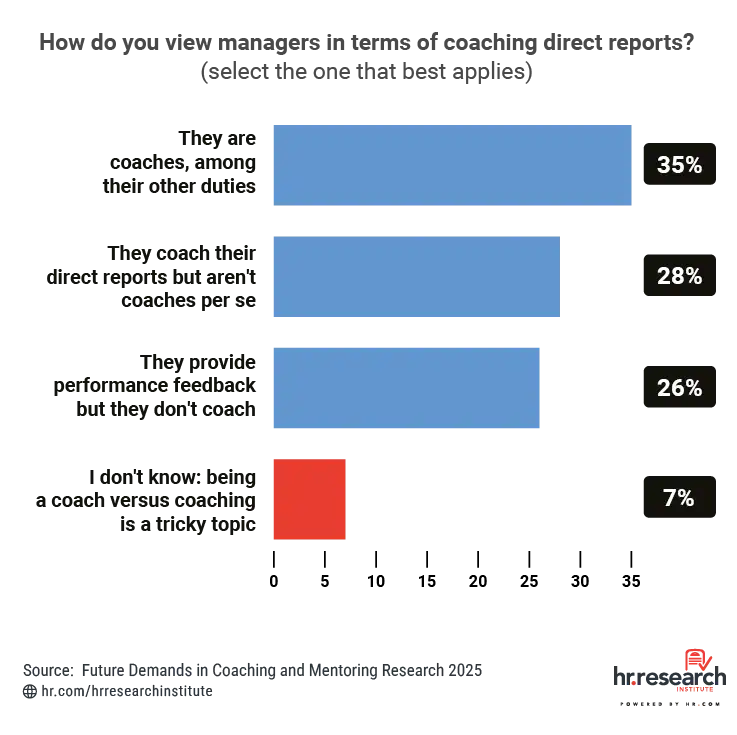
Respondents that use external coaches most frequently cited the following criteria: experience (37%), rates and fees (31%), and referrals from trusted colleagues, consultants, clients (31%).
Notably, more than a third of organizations (35%) said they do not utilize external coaches at all. This may reflect either a preference for developing internal coaching capacity or a lack of budget or perceived value in outsourcing these services.
The emphasis on trust, experience, and referrals over more formal credentials (e.g., ICF certifications were cited by only 18%) suggests that buyers may prioritize relational factors and proven track records over standardized qualifications.
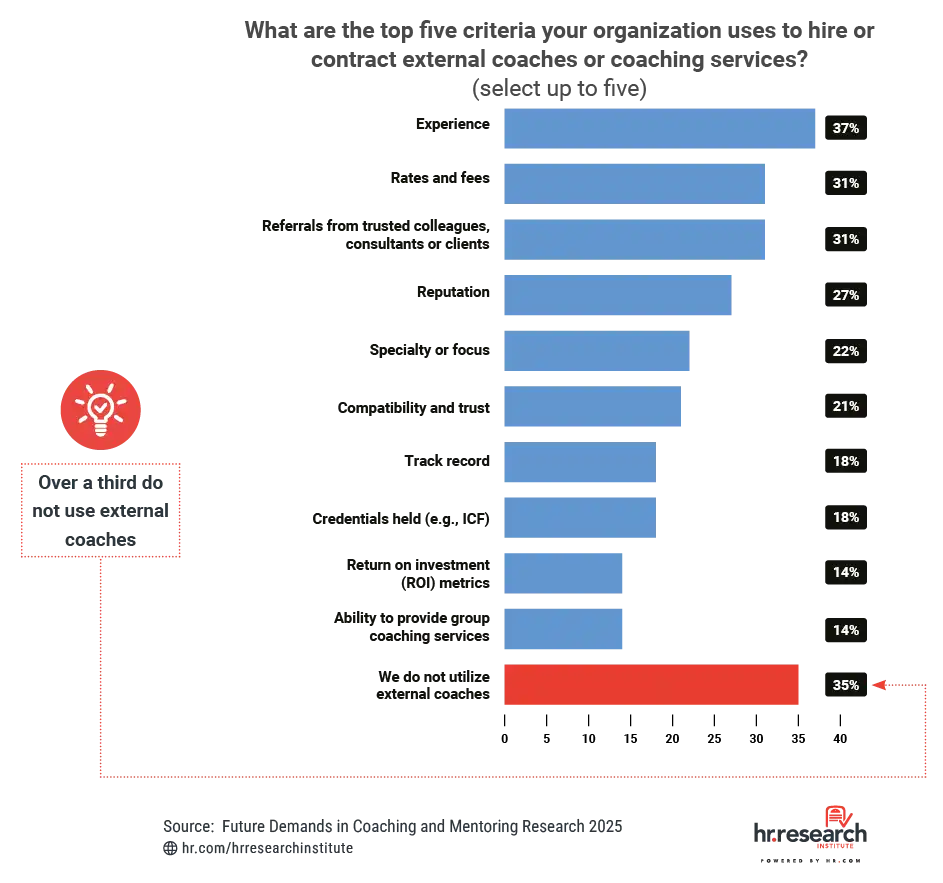
Technology plays an important but uneven role in supporting coaching and mentoring. The most common tools are video platforms like Zoom, used by 51% of organizations to enable remote sessions. Goal setting (43%) and e-learning through LMS platforms (39%) also appear prominently, showing that many organizations integrate coaching into broader learning ecosystems.
Meanwhile, advanced uses like AI-based automation are rare; only 11% report automating any coaching or mentoring aspects.
Surprisingly, nearly one in five organizations (19%) said they use no technologies at all for these purposes. This suggests a digital divide, where some employers are adopting tech-enabled development strategies while others still rely on manual, ad hoc approaches. As coaching and mentoring become more central to organizational priorities, investments in scalable, digital infrastructure may be key to expanding access and impact.
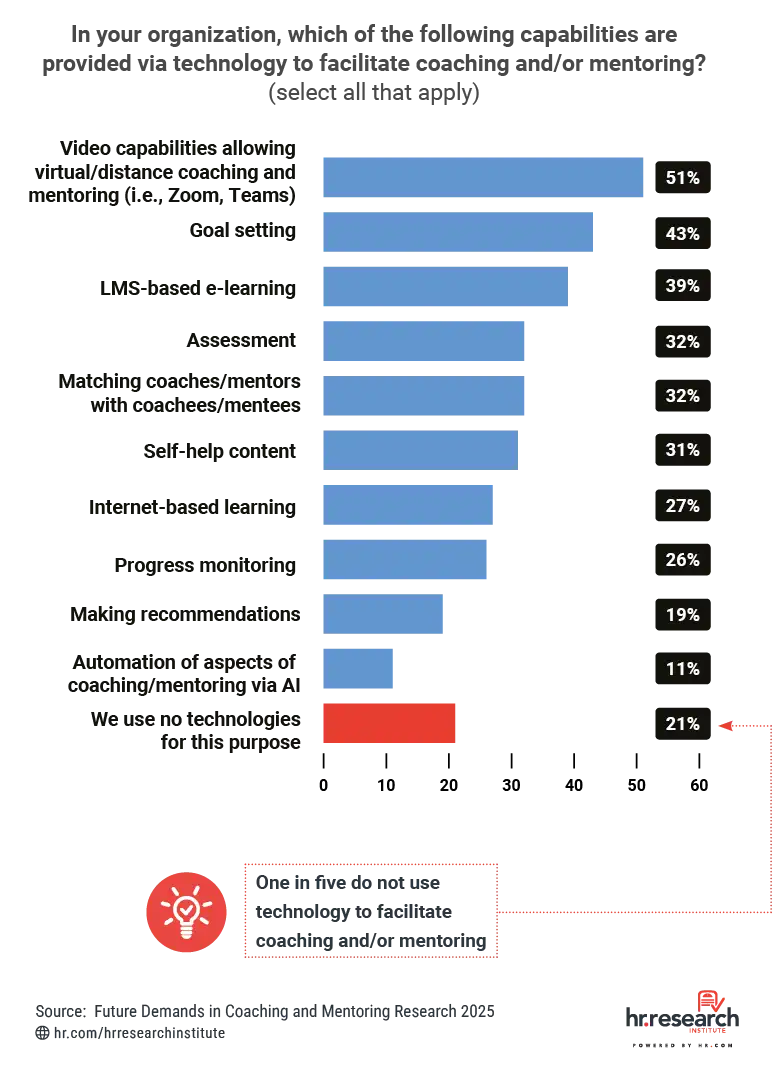
When asked about the role of artificial intelligence in coaching and mentoring over the next two years, most respondents pointed to targeted, supportive functions. The top anticipated uses include personalizing development to individual needs (38%), providing ideas and information to coaches or mentors (36%), and predicting learning needs or career paths (33%).
A smaller group anticipates AI helping with practical functions like matching participants (26%) or helping employees plan careers (26%). However, 28% of respondents said AI will not play any role. This suggests ongoing uncertainty or doubt about how AI fits into human-centered development practices.
While AI won’t replace human connection, it may offer scalable ways to support decision-making, enable personalization, and reduce administrative burdens.
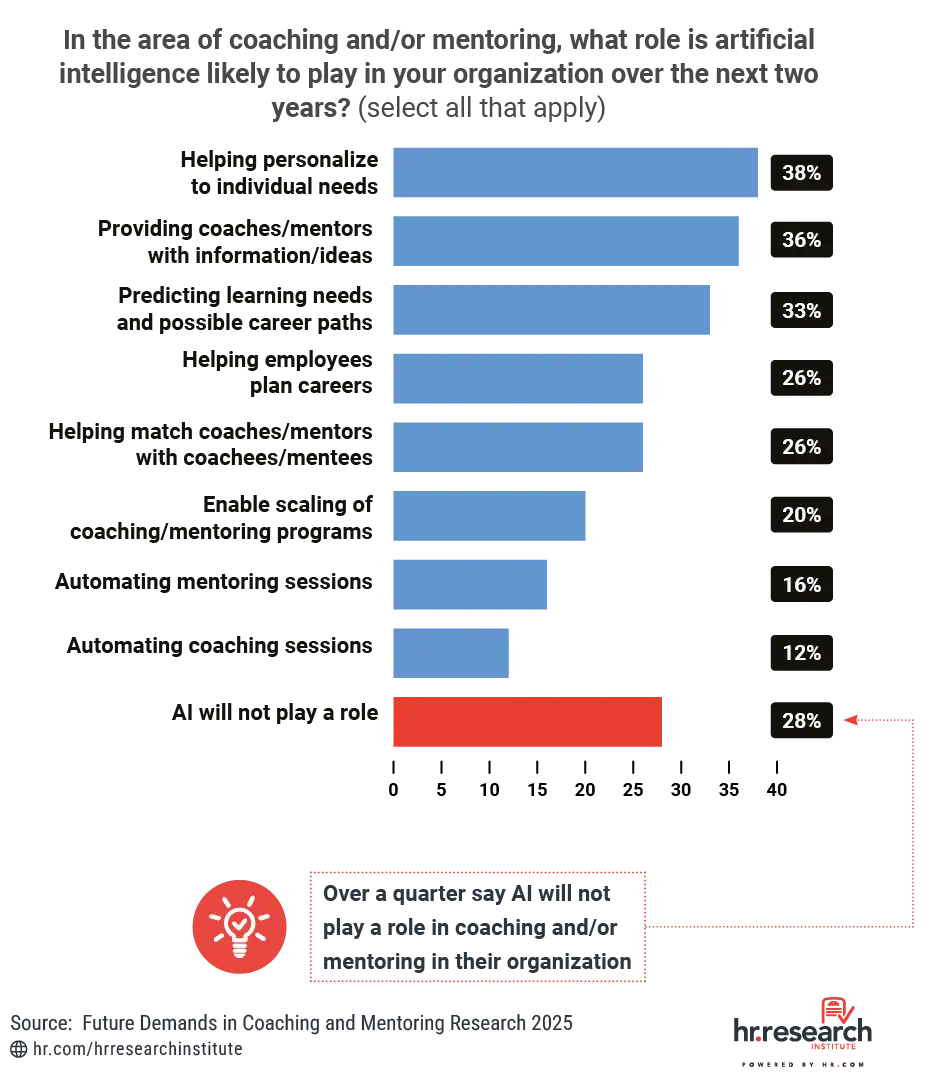
While 43% of laggard organizations say AI will not play a role in coaching and mentoring, only 15% of the leaders say the same. C&M leader organizations anticipate using AI for personalization (54%), insight generation (49%), and career planning (44%).
By contrast, the laggards report far less interest across all these applications. Only 25% expect AI to be used for personalization, and fewer than 20% expect AI will help with planning careers or predicting learning needs.
These findings suggest that C&M leader organizations are already preparing to integrate AI in ways that can enhance scale, precision, and employee development. Low-performing organizations, meanwhile, may be at risk of falling behind in the adoption of emerging talent technologies.

1. Build a supportive culture. Coaching and mentoring are most effective when they are surrounded by an organizational culture that values these efforts. These activities require planning, quality attention, and time. A strong foundation for coaching and mentoring comes from a culture in which people share their ideas, accept feedback, and continuously learn from successes and failures alike. Further, recognize those who excel at coaching. Building this sort of culture requires senior support, effective coaching and mentoring skills, and corporate values that reflect the importance of learning and development.
2. Invest in training coaches and mentors. Our research shows that although many agree that supervisors in their organizations are strongly encouraged to develop their coaching skills, much fewer say that coaches and mentors are well-trained for their roles. Coaches and mentors need training in key skills like listening, giving feedback, managing difficult conversations, and guiding others with confidence. These abilities often take time and practice to develop. Without training, coaching efforts may fall flat or even backfire.
3. Be proactive, not reactive. Too often, coaching is used only to correct poor performance. While this is an important reason to coach, it is reactive. Instead, focus on long-term development. Who in your organization needs guidance to realize their potential, prepare for a new role or assignment, or upskill/reskill? HR knows what’s needed of a person to fill future critical roles. Identify those with potential and use coaching and mentoring to develop their skills for the future. The goal is to be proactive in helping people succeed and supporting the business.
4. Expand your internal coaching and mentoring networks. Internally, train managers, peers, HR professionals, and other employees to coach and mentor. Encourage knowledge-sharing and collaboration across departments. At the same time, use external coaches strategically for senior leaders or high-potential individuals. Choose coaches who understand your organization’s goals, values, and culture to ensure alignment and return on investment.
5. Consider less traditional coaching practices. For example, reverse-coaching/mentoring, where a partnership between a senior-level employee and a junior-level employee is formed in which the junior-level employee helps fill in possible gaps in the more experienced person's knowledge. Another idea is group coaching, in which coaches work with individuals in groups. Similarly, team coaching is when one or more coaches work with a team to establish their collective mission, strategy, vision, and goals.
6. Measure the effectiveness of coaching and mentoring initiatives. Our research shows that those organizations proficient at coaching/mentoring see an impact on both individual employee development and organizational performance. However, in our 2024 and past research reports, over 40% of our respondents report a “lack of measurable outcomes” as a hindrance to effective coaching/mentoring. It can be difficult to measure the direct impact of coaching/mentoring because of intervening variables. Nevertheless, metrics do exist that can point to the success of coaching and mentoring. For example, individual performance metrics and goal attainment, promotions, the availability of “ready-now” talent to fill key positions, employee engagement scores, and employee retention.
7. Make the most of new technology. Before, during, and post-pandemic, coaches and mentors have been using virtual meeting platforms to continue their mutual learning. Technology like online courses to increase the skill levels of coaches/mentors and measure progress and impact are also available. With the rapid deployment of AI in the HCM space, other technological tools have arisen that can support coaching and mentoring. AI can generate ideas and information, predict learning needs and possible career paths, and personalize coaching and/or mentoring to individual needs. It can also be employed to match coaches/mentors with coachees/mentees.
8. Choose external coaches who align with your organizational needs. For a high potential leader or executive, coaching can be a good investment. External coaches and mentors can also be expensive. Therefore, your organization should expect a reasonable return. When using external coaches, ensure they align with your business goals. Assess their experience, industry knowledge, coaching style, and credentials. A strong match between coach and coachee increases the impact and ensures the investment pays off.

say coaching and mentoring contribute to their business success to a very high degree

agree or strongly agree that internal coaches are well-trained

say mentors are rewarded and recognized for their effort
Benefit from the expertise of renowned industry professionals who have contributed to the development of this survey research, study findings, and virtual event presentations.